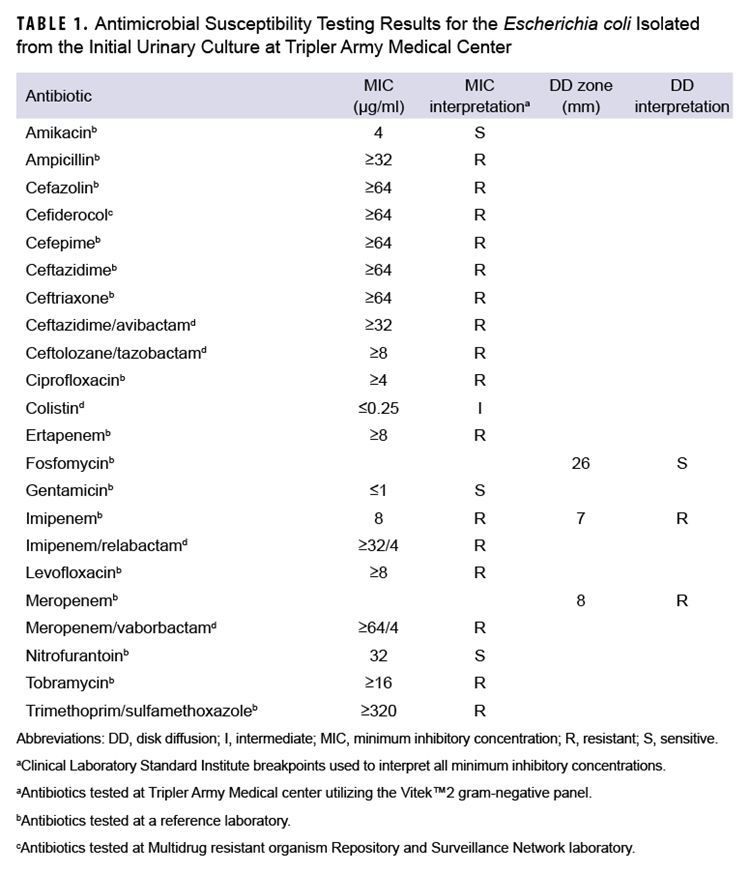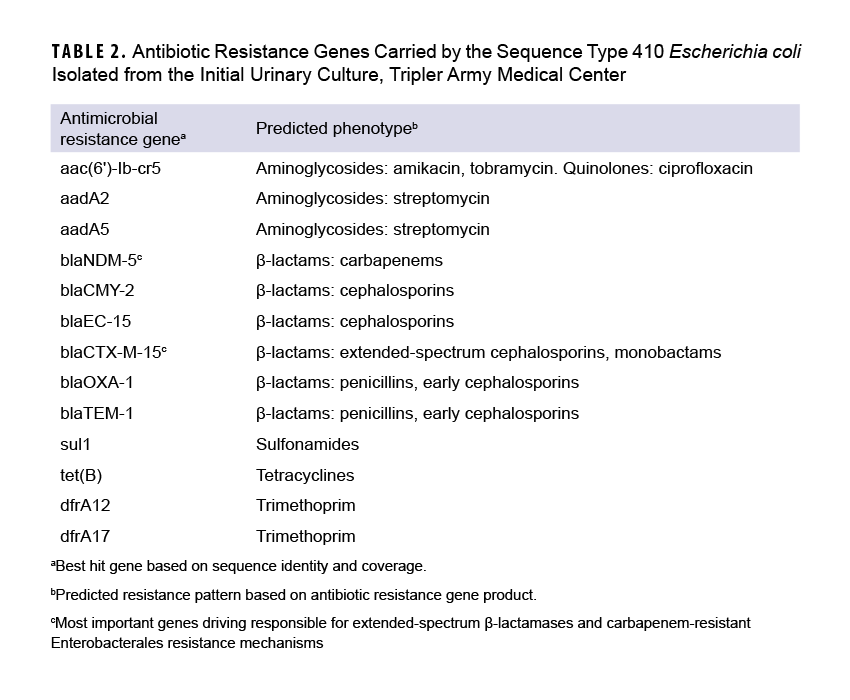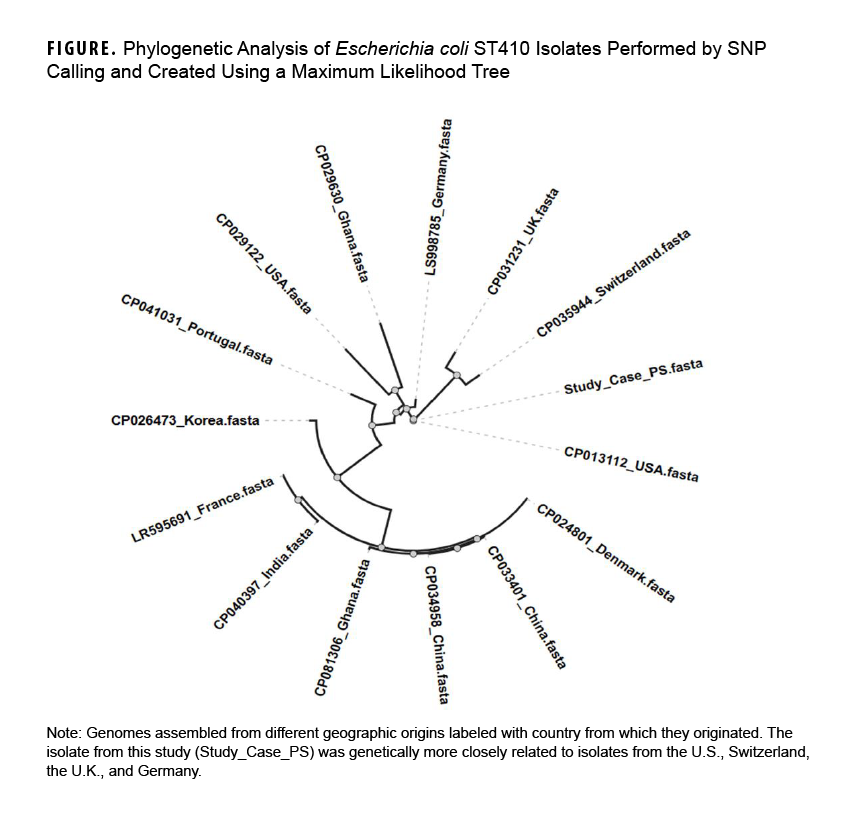Antimicrobial resistance is an important global health threat.1 From 2019 to 2020, the U.S. Centers for Disease Control and Prevention reported a 15% increase in resistant infections during U.S. hospitalizations, including a 35% increase of carbapenem-resistant Enterobacterales.2 The burden, distribution, and pattern of AMR as well as its determinants of resistance vary widely across the globe, with increased travel and movement of goods important in determining the distribution patterns of resistance.3,4 Although complex and multi-sectoral, the main drivers of AMR include misuse and overuse of antimicrobials.5 Low- and middle-income countries often have limited or non-existent regulations on antibiotic use, resulting in over-the-counter sales with limited oversight on drug quality or genuineness.5,6 Patients who travel abroad and seek medical care are at increased risk of infection with resistant organisms, depending on the region or country in which they receive care.7 The expression of carbapenemases, including metallo-ß-lactamases, is a significant resistance mechanism among CREs. A major MBL is the New Delhi MBL (NDM), which confers extensive resistance to cephalosporins and carbapenems. NDM is endemic in the Indian subcontinent but has spread to other parts of the world.4,8 Clinically, patients infected with resistant organisms often experience delay in effective treatment and may experience worse outcomes.4
With U.S. military personnel deployed in over 160 countries, including many with higher rates of AMR, service members face a threat of exposure to resistant organisms with inherent risk to their medical readiness. Additionally, other Department of Defense beneficiaries, family members, retirees, and veterans may travel to areas with increased AMR. Individuals infected or colonized with resistant organisms returning to DOD care facilities increase the risk of AMR spreading within the Military Health System, putting SMs and beneficiaries at risk and potentially affecting military readiness. Herein we report a case of a 76-year-old man who traveled to Israel and Dubai, then returned to the U.S., where he was admitted at Tripler Army Medical Center with a complicated urinary tract infection with a NDM-producing Escherichia coli.
Case Report
A 76-year-old male veteran with extensive medical history including chronic kidney disease presented to the TAMC emergency department with generalized weakness, pain, and confusion. The ED placed a catheter and drained a liter of purulent urine. The patient had evidence of fluid overload on examination and radiography. His laboratory results demonstrated an elevated blood urea nitrogen and creatinine, and a white blood cell count of 19.3 cells/µL (range 3.9-10.6 cells/µL). Additionally, his urinalysis had >182 WBC per high-powered field, positive leukocyte esterase, and many WBC clumps. Because the admitting team did not have a full exposure history due to the patient’s altered mental status, he was started on empiric ceftriaxone.
The care team subsequently learned that the patient recently returned from a trip to Israel and Dubai. While in Dubai, the patient fell ill, requiring a 4-week hospitalization during which he was treated for COVID-19 pneumonia, a non-ST-segment-elevation myocardial infarction, and acute chronic kidney failure requiring hemodialysis via a tunneled right internal jugular central venous catheter. It is unknown how long he had a urinary catheter while hospitalized in Dubai. During his 4-week hospitalization he received various broad-spectrum antibiotics including piperacillin/tazobactam, linezolid, meropenem, amikacin, and ceftriaxone. Full culture data from this hospitalization were not available.
The patient's urine culture upon admission to TAMC grew extensively drug-resistant E. coli (Table 1).

The primary team placed the patient on contact precautions and consulted the Infectious Disease team, who recommended switching the antibiotics to meropenem/vaborbactam, removing the urinary catheter, and obtaining a renal ultrasound to assess for pyelonephritis and urolithiasis. On hospital day four, the ID team recommended switching antibiotics to ceftazidime/avibactam plus aztreonam due to concerns the isolate carried an MBL. The renal imaging demonstrated non-obstructing renal calculus versus vascular calcification, the blood cultures had no growth, and the patient improved on therapy resulting in the recommendation to transition to fosfomycin on hospital day nine to complete a 14-day course. The patient made a full recovery from his infection. For further analysis, the bacteria isolate was submitted to the Multidrug resistant organism Repository and Surveillance Network at the Walter Reed Army Institute of Research in Silver Spring, Maryland. In addition to extended susceptibilities, MRSN performed whole genome sequencing on Illumina MiSeq benchtop sequencer (Illumina Inc., San Diego, CA). Based on WGS, the multilocus sequence-typing analysis revealed that the isolate belonged to sequence type 410 (ST410) and carried several resistant genes including blaNDM-5 and blaCTX-M-15 (Table 2).

To further investigate the genetic sub-lineage, phylogenetic analysis using a recently described platform9 compared the isolate from our patient to representative global E. coli ST410 strains (Figure).

Discussion
This patient returned from overseas travel and presented to a military hospital with cUTI due to E. coli ST410, a multi-drug-resistant strain found in humans, animals, and the natural environment that is shown to be spreading globally.10 It is likely the infection occurred in Dubai, where the patient received broad spectrum antibiotics, had placement of a urinary catheter, and was initiated on hemodialysis, placing him at increased risk for nosocomial infection. At TAMC the ID team, Microbiology laboratory, and Infection Prevention and Control team collaborated closely to ensure that the patient received appropriate treatment and infection control measures, resulting in successful treatment and prevention of transmission to other patients or hospital staff. TAMC notified the Hawai’i Department of Health, and subsequent surveillance efforts demonstrated no spread of this strain to other patients.
Hospital outbreaks due to the ST410 clones carrying the NDM genes have been reported in Europe,10 China,11 the Republic of Korea,12 and Rwanda.13 Epidemiological studies have shown that European and Northern American ST410 clones differ from Southeast Asian clones, the latter demonstrating multiple introductions and independent circulation.14 Based on phylogenetic analysis, this isolate clustered more closely with European isolates. This result was unexpected, given the proximity of Dubai to India compared to Europe, and the fact bacteria carrying the NDM gene are endemic in India.4 There are no reports, however, of ST410 strains carrying an NDM gene in India,15 nor in the United Arab Emirates.16
The World Health Organization has declared AMR one of the 10 leading global public health threats facing humanity, with significant cost to the world economy.1 The National Action Plan for Combating Antibiotic-Resistant Bacteria presents coordinated, strategic actions of the U.S. Government to improve the health and well-being of all Americans by changing the course of antibiotic resistance.17 In the U.S. more than 2.8 million AMR infections occur each year, resulting in more than 35,000 deaths, at an additional direct health care cost of US $20 billion.2 Without proper countermeasures, AMR may render most current antibiotics ineffective. Adequate infection prevention and control measures are critical in the fight against AMR, requiring appropriate and adequate practices to ensure prompt identification of infections caused by AMR pathogens. These practices not only ensure patients are properly isolated, and that measures limit environmental contamination which may lead to establishing endemicity of AMR pathogens in hospitals or communities, but also ensure patients are treated adequately with effective antibiotics or other measure such as phage therapy.
From January 2021 until September 2022, the HDOH reported 16 NDM-producing Enterobacterales, including E. coli isolates (Garret Hino Jr., PharmD, Public Health Pharmacist, HDOH, email communication, March 6, 2023). Due to its proximity to areas of greater AMR incidence, coupled with its high rates of tourism and the movement of military personnel, Hawai’i is at significant risk of AMR exposure. It is important that Hawai’i hospitals and the HDOH remain vigilant in assessing risk and monitoring for the introduction or spread of resistant organisms.
This is the first reported case of infection with a clone of E. coli ST410 with reduced susceptibility to cefiderocol and colistin. These drugs often represent the last resort for treatment of highly resistant gram-negative pathogens. Cefiderocol, a novel siderophore-cephalosporin conjugate, has a broad range of activity against gram-negative pathogens. Although uncommon, resistance to cefiderocol (minimum inhibitory concentration [MIC]=16 µg/ml) appears to be multifactorial, with Enterobacterales-producing NDMs generally having elevated cefiderocol and colistin MICs.18-20 Prior reports demonstrated that Enterobacterales-harboring blaNDM-1 typically have MICs of 4 µg/mL, which is considered non-wildtype.17,18 Whereas our isolate possessed blaNDM-5 and had high level resistance, it is unclear if the NDM or a combination of multiple mechanisms resulted in a MIC=64. Additionally, the isolate did not exhibit the mcr-1 gene, typically the mechanism of an elevated colistin MIC, which requires further investigations.
The patient responded well to treatment with ceftazidime/avibactam in combination with aztreonam, the preferred treatment options for infection with NDM and other MBL-producing organisms.21 Aztreonam withstands hydrolysis by MBLs but is generally susceptible to hydrolysis by serine ß-lactamases including extended-spectrum ß-lactamases, but ceftazidime/avibactam provides this additional protection. Fosfomycin provided an effective oral option once systemic complications were excluded.21
This case of cUTI due to an extensively resistant E. coli ST410 clone, in a returning traveler likely infected in Dubai, is the first ST410 reported with decreased susceptibility to both cefiderocol and colistin. It is important to consider colonization or infection with highly drug-resistant organisms in patients with a travel history outside the U.S. A multidisciplinary approach ensured that this patient received optimal care, resulting in a full recovery, and prevented nosocomial transmission.
References
- World Health Organization. Global Antimicrobial Resistance and Use Surveillance System. Report: 2022. Accessed April 10, 2023. https://www.who.int/publications/i/item/9789240062702
- Centers for Disease Control and Prevention. COVID-19 and Antimicrobial Resistance. Accessed April 10, 2023. https://www.cdc.gov/drugresistance/covid19.html
- Kazmierczak KM, Karlowsky JA, de Jonge BLM, Stone GG, Sahm DF. Epidemiology of carbapenem resistance determinants identified in meropenem-nonsusceptible Enterobacterales collected as part of a global surveillance program, 2012 to 2017. Antimicrob Agents Chemother. 2021;65(7):e0200020. doi:10.1128/AAC.02000-20
- Suay-García B, Pérez-Gracia MT. Present and future of carbapenem-resistant Enterobacteriaceae infections. Antibiotics (Basel). 2019;8(3):122. doi:10.3390/antibiotics8030122
- Iskandar K, Molinier L, Hallit S, et al. Drivers of antibiotic resistance transmission in low- and middle-income countries from a “one health” perspective: a review. Antibiotics (Basel). 2020;9(7):372. doi:10.3390/antibiotics9070372
- Batista AD, A. Rodrigues D, Figueiras A, et al. Antibiotic dispensation without a prescription worldwide: a systematic review. Antibiotics. 2020;9(11):786. https://doi.org/10.3390/antibiotics9110786
- Arcilla MS, van Hattem JM, Haverkate MR, et al. Import and spread of extended-spectrum ß-lactamase-producing Enterobacteriaceae by international travellers (COMBAT study): a prospective, multicentre cohort study. Lancet Infect Dis. 2017;17(1):78-85. doi:10.1016/S1473-3099(16)30319-X
- Gupta N, Limbago BM, Patel JB, Kallen AJ. Carbapenem-resistant Enterobacteriaceae: epidemiology and prevention. Clin Infect Dis. 2011;53(1):60-67. doi:10.1093/cid/cir202
- Liang Q, Liu C, Xu R, et al. fIDBAC: a platform for fast bacterial genome identification and typing. Front Microbiol. 2021;18;12:723577. doi:10.3389/fmicb.2021.723577
- Roer L, Overballe-Petersen S, Hansen F, et al. Escherichia coli sequence type 410 is causing new international high-risk clones. mSphere. 2018;3(4):e00337-e003318. doi:10.1128/mSphere.00337-18
- Li J, Yu T, Tao XY, et al. Emergence of an NDM-5-producing Escherichia coli sequence type 410 clone in infants in a children’s hospital in China. Infect Drug Resist. 2020;13:703-710. doi:10.2147/IDR.S244874
- Kim JS, Yu JK, Jeon SJ, et al. Dissemination of an international high-risk clone of Escherichia coli ST410 co-producing NDM-5 and OXA-181 carbapenemases in Seoul, Republic of Korea. Int J Antimicrob Agents. 2021;58(6):106448. doi:10.1016/j.ijantimicag.2021.106448
- Eger E, Heiden SE, Korolew K, et al. Circulation of extended-spectrum beta-lactamase-producing Escherichia coli of pandemic sequence types 131, 648, and 410 among hospitalized patients, caregivers, and the community in Rwanda. Front Microbiol. 2021;12:662575. doi:10.3389/fmicb.2021.662575
- Nadimpalli ML, de Lauzanne A, Phe T, et al. Escherichia coli ST410 among humans and the environment in Southeast Asia. Int J Antimicrob Agents. 2019;54(2):228-232. doi:10.1016/j.ijantimicag.2019.05.024
- Devanga Ragupathi NK, Vasudevan K, Venkatesan M, Veeraraghavan B. First Indian report on B4/H24RxC ST410 multidrug-resistant Escherichia coli from bloodstream infection harbouring blaOXA-181 and blaCTX-M-15. J Glob Antimicrob Resist. 2020;22:568-570. doi:10.1016/j.jgar.2020.06.013
- Mouftah SF, Pál T, Darwish D, et al. Epidemic IncX3 plasmids spreading carbapenemase genes in the United Arab Emirates and worldwide. Infect Drug Resist. 2019;12:1729-1742. doi:10.2147/IDR.S210554
- U.S. Department of Health and Human Services. National Action Plan for Combating Antibiotic-Resistant Bacteria, 2020-2025. Accessed July 31, 2023. https://www.hhs.gov/sites/default/files/carb-national-action-plan-2020-2025.pdf
- Yamano Y. In vitro activity of cefiderocol against a broad range of clinically important gram-negative bacteria. Clin Infect Dis. 2019;69(Suppl 7):S544-S551. doi:10.1093/cid/ciz827
- Simner PJ, Beisken S, Bergman Y, Ante M, Posch AE, Tamma PD. Defining baseline mechanisms of cefiderocol resistance in the Enterobacterales. Microb Drug Resist. 2022;28(2):161-170. doi:10.1089/mdr.2021.0095
- Kohira N, Hackel MA, Ishioka Y, et al. Reduced susceptibility mechanism to cefiderocol, a siderophore cephalosporin, among clinical isolates from a global surveillance programme (SIDERO-WT-2014). J Glob Antimicrob Resist. 2020;22:738-741. doi:10.1016/j.jgar.2020.07.009
- Tamma PD, Aitken SL, Bonomo RA, Mathers AJ, van Duin D, Clancy CJ. Infectious Diseases Society of America 2022 guidance on the treatment of extended-spectrum ß-lactamase producing Enterobacterales (ESBL-E), carbapenem-resistant Enterobacterales (CRE), and Pseudomonas aeruginosa with difficult-to-treat resistance (DTR-P. aeruginosa). Clin Infect Dis. 2022;75(2):187-212. doi:10.1093/cid/ciac268
Author Affiliations
Tripler Army Medical Center, Honolulu, Hawaii, USA: Drs. Edwin Kamau (LTC, USA), Viseth Ngauy (COL, USA), Nathanial K. Copeland (LTC, USA), Mr. Christopher Harens, and Ms. Han Ha Youn; and Multidrug resistant organism Repository and Surveillance Network, Walter Reed Army Institute of Research, Silver Spring, MD: Drs. Patrick T. McGann, Francois Lebreton, Brendan Jones, and Jason W. Bennett (COL, USA)